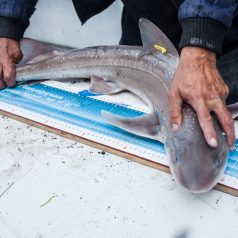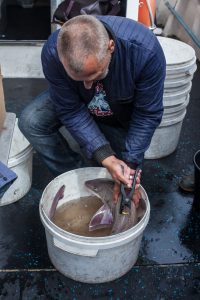
Recently, the St Maarten Nature Foundation initiated a program tagging sharks in the marine park. The research is aimed at better understanding the biological characteristics of sharks in St. Maarten waters including population structure, abundance and migration.
In the Dutch Oosterschelde estuary, sharks are being tagged for several years within a project by Sportvisserij Nederland. This tagging program concerns the starry smoothhound (Mustelus asterias), a bottom dwelling shark species that grows to a maximum 1,5 meters and feeds on small crustaceans, swimming crabs and bristle worms. In cooperation with recreational anglers, the smoothhound are captured with a rod and equipped with a small personal identification tag. Each individual is also measured for size, sexed, and release back into the water safely. This method is called tag and recapture. Usable data is obtained once the animal is recaptured after a certain time period, from which it can be deduced how far it swam, and how fast it grew. The first results of the smoothhound study were published in an article in the Journal of Fish Biology.

Tagging sharks is a pivotal first step in determining how sharks use our waters and is essential for improvement of management and protection. Both in the Netherlands and the Dutch Caribbean, it is reassuring that these first step are taken, so that the baseline situation of sharks in our water can be assessed for future reference. The Dutch Save Our Sharks team joined a charter boat in Zeeland for two days in July and August to fish for sharks and tag these for the study about shark migration in the North Sea. Accompanied by youth ambassador Felipe Saelmans, Imares, the DCNA, the Postcode Lottery, Dutch Angling Association, and multiple journalists, the fishing trip provided a great opportunity to show everybody what the tagging process entails, and how such research can contribute to improving management measures.

The weather was less than ideal on both fishing days, so the fishing had to occur within the weir, where generally fewer fish are caught. Therefore, the total catch of both days only included a single shark. The 1,01 meter long female smoothhound received the tag in her dorsal fin before she was returned to the sea. She swam right under the surface for a few seconds, only to return back into the deep. Another special catch was a common stingray (Dasyatis pastinaca), a close relative of the American stingray that occurs around the Dutch Caribbean islands. The common stingray is regularly observed in the Oosterschelde, although its population structure is still obscure, and it is unknown how the local population is structured.
Because of the fishing trip, Dutch media got acquainted with the science underpinning shark conservation and it was covered broadly in magazines and on the radio.





